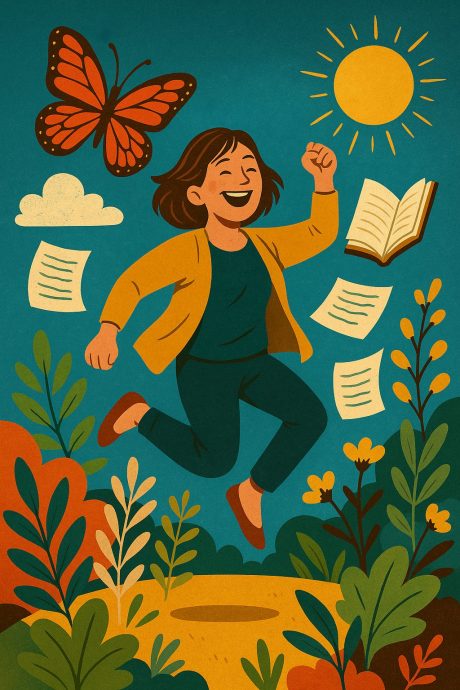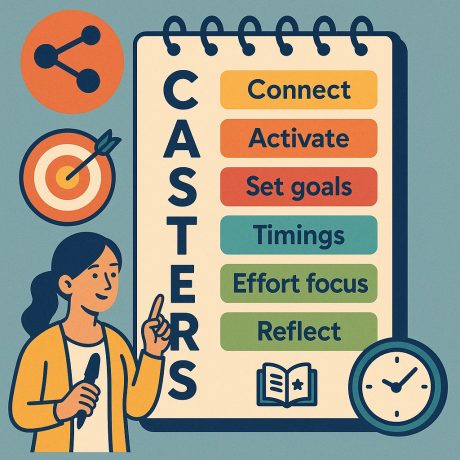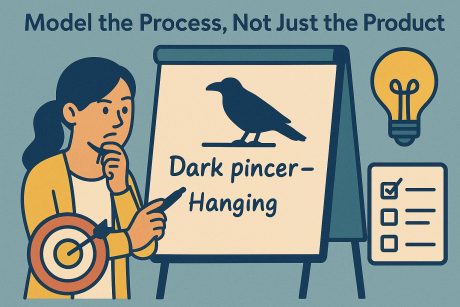Learning from Fiona Plant’s Masterclass

On 19 June 2025, we were privileged to host a remarkable masterclass by Fiona Plant, an alumnus of the MA in Creative Writing and Education, who is also an inspirational primary teacher and resource designer. Fiona led a vibrant, resource-rich session on how to teach poetry effectively, especially to younger children. Her workshop was packed with practical ideas, pedagogical insight, and joyful creativity.
Here are five key takeaways from Fiona’s session that every educator — whether in primary, secondary, or informal settings — can apply to bring poetry to life in their teaching.
1. Begin with Connection and Play

Fiona showed us that one of the most powerful ways to engage learners is through connection and creative play. She began with a deceptively simple activity: the “I Am…” Post-it Poem. Each participant completed the sentence “I am…” with one or two identities or roles, such as “teacher,” “carer,” “cat lover,” “book reader”, and stuck their notes onto sugar paper. The results were shaped into a collective list poem.
“It’s such a simple exercise, but it’s so connecting, isn’t it?”
“It allows a class to get a sense of who we all are, without going round and making everyone speak. It’s inclusive, poetic, and playful all at once,” Fiona explained.
Other warm-up ideas included:
- Metaphorical Animal Names: “I am a tiger…” leads into rich similes and metaphors.
- Mirror Poems: Students describe themselves using a mirror frame template.
- Group Recipes: Mix learners’ traits into a metaphorical class recipe.
- Exquisite Corpse Writing: A surrealist group poem game where each person writes a line (e.g. “How did you get here today?”), folds it over, and passes it on. The final revealed poem is often surprising and delightful.
These activities were not only fun—they also introduced poetic structure, metaphor, and rhythm subtly and accessibly.
2. Use the CASTERS Framework Creatively

Fiona structured the session around CASTERS—a mindful lesson design framework developed by me:
Connect
Activate prior knowledge and Assess
Set goals and learning activities
Timings
Effort focus
Reflect
Set independent learning
“The framework really helps you stay intentional,” Fiona said. “I didn’t stick to it rigidly, but it was a great checklist to make sure every session had purpose, reflection, and creativity at its heart.”
Throughout the session, CASTERS helped frame each activity:
- “Connect” through warm-ups like the “I Am…” poem.
- “Activate” by discussing what poetry means to students.
- “Set goals” such as writing metaphor poems or exploring sensory language.
- “Timings” kept the lesson fluid yet purposeful.
- “Effort focus” ensured that students—not teachers—did the creative heavy lifting.
- “Reflect” was embedded via group sharing and discussion.
- “Set independent learning” occurred when learners were invited to write poems at home or build on activities later.
“I’d never really thought about lesson planning this way before,” said one participant. “It gives poetry teaching a kind of rhythm without making it rigid.”
3. Model the Process, Not Just the Product

A standout insight was the power of modelling live writing. Fiona encouraged teachers to share their thought processes out loud and let students see real writing unfold: hesitations, revisions, even clichés included.
“Modelling is really difficult for non-writers,” she admitted, “but it’s one of the most powerful things you can do. Show that you get stuck. Say it out loud. Let the children help you improve it.”
Activity: Live Metaphor-Making
Working from an image of a raven, participants composed a collaborative poem line-by-line:
“Dark pincers cradling a glistening orb;
Sinister stare;
Wings still;
Hanging vampire cloak…”
Each phrase was built through group input, modelled by Fiona on the board. The process made poetic choices visible and helped participants reflect on tone, sound, and imagery. As Fiona noted, “You can’t just show a finished poem and expect them to get there. They need to see how it’s made.”
4. Use Images and Sensory Prompts to Spark Writing

Fiona shared beautiful illustrated bird cards inspired by The Lost Words(Macfarlane & Morris 2017) and invited participants to describe the birds metaphorically, without naming them. This approach prioritised observation, emotional connection, and metaphor.
“Children may know what a robin looks like, but they might not know how it hops, how it sings—give them that,” Fiona explained.
Activity: Bird Metaphor Poems
- Each student selects a bird image (e.g. starling, robin, kingfisher).
- Using sensory detail, they write metaphorical descriptions without naming the bird.
- Images are supported by video clips or sound recordings to build understanding.
Examples included:
“Christmas pudding,
gardener’s friend,
sunset chest,
bringer of choice.”
OR:
“Fairy bringing gifts,
dancing on water.
Spring is here,
hope is born.”
These metaphors became the seeds for full poems or acrostics. Fiona emphasised that children often surprise you with their creativity when the starting point is strong and clear.
5. Create Space for Publishing and Purpose

For Fiona, poetry must lead to a real outcome. She urged teachers to think beyond the classroom page.
“Publishing matters. When children see their work in a real book or hear it read aloud, something shifts. They begin to believe they are poets.”
Activity: Redacted Poetry
- Using newspapers or leaflets, students highlight words or phrases and redact the rest with marker.
- The uncovered words form a new, often striking poem.
Examples from the session included:
“Spontaneous soul, life gets hectic, chasing the sun, warm cultures, sweet spot.”
examples of redacted poetry from the session
“Toxic pollution, AI dominance, precision weapons, vigilance, kill web.”
Redacted poems often reflected mood, political critique or humour. Other publishing ideas included:
- Collaborative anthologies
- Poetry performances in assemblies
- Podcast recordings or short audio dramas
- Poetry films and illustrated displays
“I’ve never had a bad poetry lesson,” Fiona said. “It just works—it brings out joy, depth, even the unexpected.”
Final Thoughts
Fiona reminded us that teaching poetry doesn’t need to be formulaic. With creativity, empathy, and careful planning, it becomes a space for liberation and joy. Whether you’re an experienced teacher or new to the classroom, Fiona’s session offered a treasure trove of tools to help young people write from the heart, and see themselves as poets.
“This has made me excited about teaching again,” one participant concluded.
Let poetry jump up: playfully, proudly, powerfully.
Useful Links and Slideshow:
You can find the resources Fiona created here:
🟢 Parklife Toolkit
🟢 In Living Memory Education Packs
Fiona’s slides can be found here:
